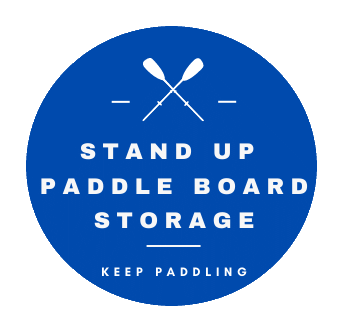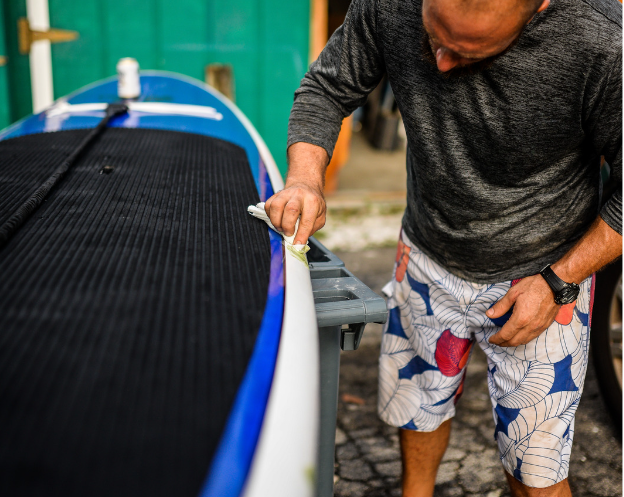Storing your stand-up paddleboard (SUP) correctly is an essential part of its care and maintenance. Incorrect storage can lead to a variety of common issues that can be easily avoided if you know what you are doing! We understand that it’s difficult to keep up with the proper techniques for SUP storage, which is why we’ve put together this guide to help you avoid some of the most common mistakes people make. Here, we’ll list our top five no-nos when it comes to storing your board and offer advice on how best to look after it, so don’t fret–you’ll be ready in no time. Read on for everything you need to know about keeping your board safe between sessions!
Mistake #1 – Storing Your SUP in Direct Sunlight
One of the most damaging mistakes you can make when storing your SUP is storing it in direct sunlight. So why is this such a problem? Well, it turns out that UV rays can cause some serious damage to your board, including color fading, cracking, and even warping. Not exactly what you want for your beloved board! Thankfully, there are a few tips you can follow to avoid this mistake altogether. For example, try using a UV-protective cover, which will offer some extra protection against those pesky rays. Another option is to store your SUP in a shaded area, like underneath a tree or in a covered storage unit.
Mistake #2 – Storing Your SUP on a Flat, Hard Surface
Another common mistake that many of us make is storing the SUP flat on a hard surface. This may seem like a convenient option, but it can cause a lot of damage to your board such as pressure dings, warping, etc. So what can you do to avoid this? Well, there are plenty of options out there such as using a rack or stand to lift the board off the ground or padding the surface with foam or blankets. These methods are not only safer for your board, but they’ll also give you peace of mind knowing that your SUP is being stored properly.
Mistake #3 Storing Your Board Without Proper Cleaning
One of the most common stand up paddle board storage mistakes is not cleaning your SUP properly before storing it. This can lead to saltwater corrosion and a buildup of dirt and grime, which can damage the board’s surface and make it more susceptible to leaks or other issues. To avoid these problems, it’s important to properly clean and dry your SUP before storing it. Start by rinsing it with fresh water and wiping it down with a soft cloth. Then, make sure it’s completely dry before putting it away. A little extra effort now will go a long way in keeping your SUP in top condition for future paddle sessions!
Mistake #4 – Storing Your Board in Extreme Temperature
If you’re a proud owner of a stand up paddle board, you know how important it is to take care of it properly. Storing your SUP might seem like an easy task, but it’s crucial to avoid mistakes that could impact its lifespan. One common mistake that many people make is storing their SUP in extreme temperatures. Both hot and cold temperatures can cause damage like delamination and cracking, which can be a huge bummer. To avoid these issues, it’s best to find a storage location that offers a stable, moderate temperature.
Mistake #5 – Storing Your SUP Near Sharp or Heavy Objects
Sure, sounds obvious but one of the biggest mistakes you can make is storing the SUP near sharp objects or heavy equipment. I mean, think about it – punctured holes or big dents in your board don’t exactly scream “good times!” Plus, it’s just plain dangerous to have heavy equipment or objects looming over your board. So, to prevent any unpleasant accidents, it’s best to store your SUP in a safe location, away from sharp or heavy stuff. Paddle racks or hooks installed in a secure location can be a great solution. Year after year I’m shocked at how many stories I hear about people bringing out their boards for the first time of the season only to find it damaged by some object.
Final Strokes
Storing your standup paddle board properly is key to ensure you and your family are able to make the most of your time together on the water year after year. Mistakes like storing in direct sunlight, a hard surface, without cleaning, in extreme temperatures or near sharp objects or heavy equipment can all cause long-term damage. So be sure to prevent these mistakes at all costs! But even though we’ve discussed potential dangers, SUP storage doesn’t have to be daunting – rather it should be seen as a way to better protect and enjoy your newfound activity. Now that you’ve read our guide on how avoid common skateboard storage mistakes, what tips will you use? What mistakes have you made when it comes to storing your SUP? Feel free to share any helpful insight in the comments below and let’s keep paddling!



Recent Comments